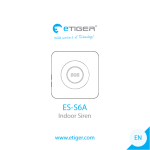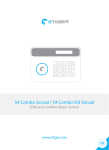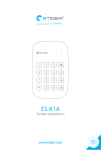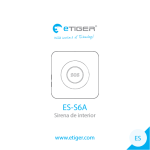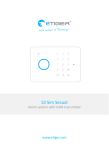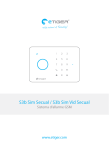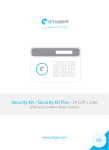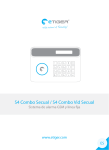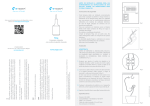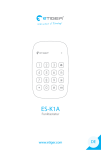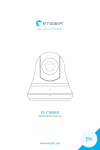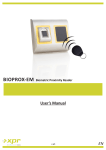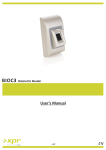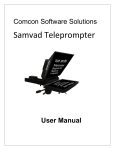Download ES-K1A - eTIGER
Transcript
ES-K1A Wireless Keypad www.etiger.com EN Foreword Thank you for purchasing the ES-K1A. The ES-K1A is a keypad that enables you to arm and disarm your alarm system, or arm it in Home Mode. Before entering your home, all you need to do is to type your passcode and press the Disarm button [ ], or swipe the RFID tag (sold separately) in front of the RFID reader to disarm the system. Box Content Keypad x 1 AAA 1.5V batteries x 3 Screws x 4 Documentation 2 Appearance LED indicator RFID reader1 Arm / Unlock Disarm Home Mode / Unlock SOS Key 1 RFID tag (125 KHz) sold separately. The keypad supports up to 50 RFID tags. Refer to the instructions on page 9 of this manual to learn how to register an RFID tag in the keypad. 3 RFID Tag Rear cover Battery compartment Tamper switch 4 Preparation Before Use How to turn the ES-K1A on The ES-K1A is powered by 3 AAA batteries. Before using for the first time, remove the battery strip. 1. Unscrew and open the case. 2. Insert the batteries according to the positive and negative signs. 3. Close the case and screw it back. Remark Because of the tamper switch, opening the rear cover of the keypad when the latter is on triggers the alarm. In such case, stop the alarm by disarming the system, as explained in page 10 of this manual. 5 Installation 1. Unscrew the case and open it. 2. Screw the rear cover to a door frame or to a wall. 3. Fasten the front cover of the keypad to the rear cover and screw them together. Remark Because of the tamper switch, opening the rear cover of the keypad when the latter is on triggers the alarm. In such case, stop the alarm by disarming the system, as explained in page 10 of this manual. 6 Setup The ES-K1A operates under 4 modes. Normal mode The LED indicator blinks once every 5 seconds. Sleep mode Under Normal mode, the keypad switches to Sleep mode if no operation is made for 35 seconds. Press the Arm [ ] or Home Mode [ ] keys to exit Sleep mode. When the keypad is in Sleep mode, the LED indicator is off. RFID Reader mode Under Normal mode, press [*] on the keypad to activate the RFID reader for 10 seconds: the LED indicator turns on. After 10 seconds, the LED light turns off as the RFID reader turns off automatically. Setup mode To enter Setup mode, switch to Normal mode and then enter [your admin code + #] on the keypad. The LED indicator blinks once every second. Press [*] to exit the Setup mode and switch to the Normal mode. After 30 seconds without operation, the keypad goes back to the Normal mode. Default admin code : 123456 Remark Correct operation: 1 beep and the LED light blinks once. Wrong operation: 2 beeps and LED light blinks twice. 7 Register the ES-K1A in the control panel Make sure the control panel is in Connection mode (refer to the user manual of your eTIGER alarm system). Press Arm [ ] or Home Mode [ ] on the keypad to unlock it. Type your user code or admin code on the keypad, and then press any of the Arm [ ], Disarm [ ] or Home Mode [ ] keys. Your hear short beeps: the registration has succeeded. Default admin code : 123456. Default user code : 1234 The control panel of your alarm system can be controlled from distance on the keypad once the latter has been registered in the control panel. Connect the ES-K1A to an eTIGER siren The ES-K1A can be connected to an eTIGER indoor or outdoor siren, which enables you to trigger the siren by pressing the [SOS] key on your keypad. To connect the keypad to an eTIGER siren, set the wireless siren to Connection Mode (refer to the manual of your eTIGER siren if necessary). Press the Arm [ ] or Home Mode [ ] key on the keypad to switch to Normal Mode. Then type [your admin code or user code] and press any of the Arm [ ], Disarm [ ] or Home Mode [ ] keys on the keypad. For more information on sirens and accessories compatible with eTIGER security systems, visit our website etiger.com 8 Register an RFID tag in the ES-K1A 1. Press Arm [ ] or Home Mode [ ] on the keypad to unlock it. Then type [admin code + #] to enter Setup mode. Default admin code: 123456 If you hear 2 beeps, the code you have typed is wrong. 2. Type [41#]. You hear one beep and the LED indicator lights up: the keypad switches to Connection mode. 3. Swipe the RFID tag in front of the RFID reader. You hear one beep: the connection is successful. If you hear two beeps, the RFID tag has already been connected. Press [*] to exit Setup Mode. To clear all registered RFID tags, press any of the Arm [ ] or Home Mode [ ] keys on the keypad to unlock it, and then type [admin code+#42#]. You hear one beep: the RFID tags have been deleted from the keypad. 9 Usage The keypad can be used as a remote control. Your user code or your admin code will be required before arming or disarming the system, or switching to Home Mode or Mute Mode. Arm the system 1. Press Arm [ ] or Home Mode [ ] on the keypad to unlock it. 2. Type your user code or admin code. 3. Press the Arm key [ ]. The LED indicator blinks once, the keypad beeps once and sends to the control panel the signal to arm the system. When the alarm panel receives the signal, the siren beeps once and the Arm indicator on the control panel lights up. The alarm system is now armed. Default admin code : 123456, default user code : 1234 Disarming the system with the keypad 1. Press Arm [ ] or Home Mode [ ] on the keypad to unlock it. 2. Type your user code or admin code. 3. Press the Disarm button [ ]: the LED indicator blinks once, the keypad beeps once and sends to the control panel the signal to disarm the system. When the control panel receives the signal, the siren beeps twice and the Disarm indicator lights up: the alarm system is now disarmed. 10 Disarming by RFID tag 1. Press Arm [ ] or Home Mode [ ] on the keypad to unlock it. 2. Press [*] to activate the RFID reader for 10 seconds. 3. Within the next 10 seconds, swipe the RFID tag in front of the reader to disarm the system. The RFID reader turns off when a RFID tag is swiped in front of it, when the key [*] is pressed again on the keypad, or after 10 seconds without operation. Home Mode 1. Press Arm [ ] or Home Mode [ ] on the keypad to unlock it. 2. Type your user code or admin code. 3. Press the [ ] key: the LED indicator blinks once, the keypad beeps once and sends the signal to the control panel to switch to Home Mode. When the alarm panel receives the signal, the siren beeps once and the Home Mode indicator lights up: the alarm system is now in Home Mode. All the sensors in regular zones are armed except those in the Home Mode zone. The sensors in the Home Mode zone are disarmed so that users can move inside their home. For more information on the setup of zones, please refer to the user manual of your eTIGER alarm system. 11 Emergency call Refer to the instructions page 14 of this manual for more information on how to lock/ unlock the SOS button. With SOS button unlocked 1. Press Arm [ ] or Home Mode [ ] on the keypad to unlock it. 2. Press [SOS]. 3. The LED indicator blinks once, the keypad beeps once, and the alarm is triggered immediately. With SOS button locked 1. Press Arm [ ] or Home Mode [ ] on the keypad to unlock it. 2. Type your user code or admin code. 3. Press [SOS] to trigger the alarm immediately. Low battery indication When the battery level is low, the LED indicator blinks 3 times every 5 seconds. In such case, please change the batteries. 12 Settings Enter Setup mode Press Arm [ ] or Home Mode [ ] on the keypad to unlock it. Type [admin code+#] to enter Setup mode. Default admin code : 123456 Under setup mode, if no operation is made for 30 seconds the keypad will exit the setup mode automatically. The setup mode can also be exited by pressing [*]. Exit delay Detectors start detecting potential intrusions immediately after the system has been armed. To prevent alarms when you leave your house, an exit delay can be set up. If you have set up an exit delay, the control panel will receive the signal to arm the system when you press the Arm key [ ] on the keypad after the time set. 1. Enter Setup mode. 2. Type [33+delay time in seconds+#]. 3. You hear one beep: the setup is successful. To deactivate the Exit delay, set 0 as delay time. Remark The time is set in seconds, it can be set from 0 to 255. Default setting: 0. 13 If the exit delay has been set, the control panel will beep once every second after having pressed the Arm [ ] key. The rhythm of the beeps will speed up during the last 15 seconds. After the exit delay time has elapsed, the control panel is armed. If an exit delay has been set up for both the control panel and the keypad, the actual delay time will be the combination of both exit delays. This setting does not apply to the Home Mode. Remark Only the Exit delay can be set on the keypad. The Entry delay can be set on the control panel (refer to the user manual of your eTIGER alarm system). Lock / Unlock the SOS button Lock the SOS button 1. Enter Setup mode. 2. Type [3410#]. 3. You hear one beep: the setup is successful. If the SOS button is locked, you will need to press Arm [ ] (or Home Mode [ ]) to unlock the keypad, to type your admin or user code, then to press [SOS] to trigger the alarm. Unlock the SOS button 1. Enter Setup mode. 2. Type [3411#]. 3. You hear one beep: the setup is successful. If the SOS button is unlocked, the control panel will ring out immediately when you press Arm [ ] (or Home Mode [ ]) and then [SOS]. Remark Default setting: SOS button is locked. 14 Keyboard clicks Keyboard clicks can be turned on or off. If keyboard clicks are off, the successful setup notification sound will be off too. Turn keyboard clicks on 1. Enter Setup mode. 2. Type [3510#]. 3. You hear one beep: the setup is successful. Turn keyboard clicks off 1. Enter Setup mode. 2. Type [3511#]. Remark Default setting: keyboard clicks are on. 15 Enable / Disable deactivation by RFID tag Enable deactivation of the system by RFID tag 1. Enter Setup mode. 2. Type [3610#]. 3. You hear one beep: the setup is successful. Disable deactivation of the system by RFID tag 1. Enter Setup mode. 2. Type [3611#]. 3. You hear one beep: the setup is successful. Remark Default setting: deactivation of the system by RFID tag is enabled. 16 Change user code The user code may be required to interact with the control panel (arm or disarm the system, or switch to Home Mode). We recommend you to change the user code before using the keypad for the first time. 1. Enter Setup mode. 2. Type [38+new user code+#]. 3. You hear one beep: the setup is successful. Remark The user code must consist of 4 digits. Default user code is “1234” . Change admin code The admin code may be required to change the settings and interact with the control panel (arm or disarm the system or switch to Home Mode). We recommend you to change the admin code before using the keypad for the first time. 1. Enter Setup mode. 2. Type [39+new user code+#]. 3. You hear one beep: the setup is successful. Remark The admin code must consist of 6 digits. Default admin code is “123456”. 17 Reset After having reset the keypad, the user code, the admin code, and other settings will be restored to default settings. The RFID tags that have been registered will not be deleted from the keypad. 1. Enter Setup mode. 2. Type [987654321#]. 3. You hear one beep: the setup is successful. FAQ Problem No response from the keypad The keypad cannot be registered to the control panel Cause Solution Low battery Change the battery. The batteries’ positive and negative terminals are reversed. Remove and insert the batteries again according to the instructions in this manual. The keypad is locked Press Arm or Home Mode on the keypad to unlock it. No response from the alarm panel Make sure the alarm panel is on. 18 Make sure the alarm panel is in Connection mode. Problem Cause Solution No response from the control panel when operating on the keypad. The keypad is not registered in the control panel. Register the keypad in the control panel by following the instructions in this manual. The keypad is installed too far from the control panel. Install the keypad and the control panel closer to each other. It is recommended to buy a repeater to extend the transmission distance. Cannot disarm the system by RFID tag. The keypad cannot be set up. The keypad cannot arm, disarm or switch to Home Mode. The RFID tags have not been registered in the keypad. Register the RFID tag in the control panel according to the instructions in this manual. The RFID reader is disabled. Enter Setup mode and activate the function “Enable / Disable deactivation by RFID tag”. The keypad is locked. Press Arm or Home Mode, then [*] before disarming. The keypad is not unlocked. Refer to instructions in this manual. The keypad does not switch to Setup mode. Refer to instructions in this manual. Your user code or admin code has not been typed before each operation. Type your user code or admin code before the operation. 19 Care and Maintenance For a safer use and a longer lifetime of the ES-K1A, we recommend you to follow the instructions listed below. Usage notices General instructions - This keypad must be registered in the control panel of your eTIGER alarm system before being used for the first time. - The power supply of this keypad may impact the transmission distance of the wireless signal. - This keypad is powered by 3 x AAA batteries. - This keypad is compatible with eTIGER Secual alarm systems. - Remove the battery strip before using for the first time. - To avoid disturbing your neighborhood, do not press the [SOS] key unless necessary. - Check your keypad on a regular basis to make sure the system works properly in case of emergency. - This keypad is neither waterproof nor moisture-proof. Install it in a shady, cool and dry place. - The case of this keypad is made of ABS plastic. Please keep it away from strong light to ensure longer lifetime. Limitations - This keypad is not explosion proof. Keep it away from fire and flame sources. - Install this keypad away from objects that produce heat or electromagnetic fields such as heaters, air conditioners, microwave ovens, etc. Recycling instructions - Dispose of the keypad according to local regulations. - Do not dismantle the product if you are not a professional technician. 20 Maintenance Clean your keypad with a dry soft cloth or tissue. If there is dirt on your keypad, wipe the surface with a soft cloth and diluted detergent and then wipe again with a dry cloth. Standards This product bears the selective sorting symbol for waste electrical and electronic equipment (WEEE). This means that this product must be handled pursuant to European Directive 2002/96/EC in order to be recycled or dismantled to minimize its impact on the environment. For further information, please contact your local or regional authorities. Electronic products not included in the selective sorting process are potentially dangerous for the environment and human health due to the presence of hazardous substances. In compliance with European laws. This product is in compliance with the essential requirements and other relevant provisions of Directive 1999/5/EC. This product was designed and manufactured in compliance with Directive 2002/95/ EC of the European Parliament and of the Council on the restriction of use of certain hazardous substances in electrical and electronic equipment (RoHS Directive - RoHS) and is deemed to comply with the maximum concentration values set by the European Technical Adaptation Committee (TAC). Images, illustrations and text are non-contractual. ETIGER and the ETIGER logo are registered trademarks and the property of ETIGER. Copyright © 2015 ETIGER. All rights reserved. 21 ES-K1A–UM-EN20150303-2.1-W Manufactured in China. This user manual is available in other languages at www.etiger.com/eu/support ETIGER EUROPE Rue de la Loi, 25, 7100 La Louvière, Belgium [email protected]























